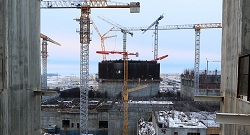Russia will supply a new reactor control and protection system (RCPS) for the now constructed Belarusian nuclear station.The new system needs no human involvement to control the reactor or shut it down in emergency situations. It has been developed by Rosatom’s subsidiary VNIIEM Corporation and is the first to be exported. The plan to install the system at Russian nuclear stations is afoot.
RCPS consists of 160 electric cabinets and racks weighing from 150 to 350 kg depending on the configuration and includes three independent subsystems. The first of them – a communication and diagnostic subsystem – analyzes sensor readings and communicate them to the control room of the nuclear station. The second subsystem monitors and controls in-pile processes. The last subsystem will shut down the reactor in case of emergency.
The new RCPS has no interblock cabling and features wireless data transmission. This reduces the number of components, makes the installation easier and adds to the system’s overall reliability. Redundancy is another specific feature of the system. No terrorist attack or natural disaster will be able to disrupt the new RCPS.
A similar system is used at Novovoronezh Unit 6, but RCPS to be installed at the Belarusian nuclear station has been improved significantly. Each component includes two independent, redundant computer systems making its operation highly reliable. If one system fails for whatever reason, the other takes full control.
Constructed near Ostrovets (Astravets), a small town in the Grodno Region of Belarus just 50 kilometers away from Vilnius, the Belarusian nuclear power plant will have two VVER-1200 reactor units with a total capacity of 2,400 MWe. The nuclear power plant is based on the standard AES-2006 Generation III+ design that offers more efficient performance and advanced safety systems in accordance with post-Fukushima requirements, as well as full compliance with applicable environmental and sanitary regulations. Unit 1 is scheduled for commissioning in 2019, to be followed by Unit 2 in 2020.




